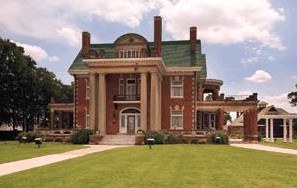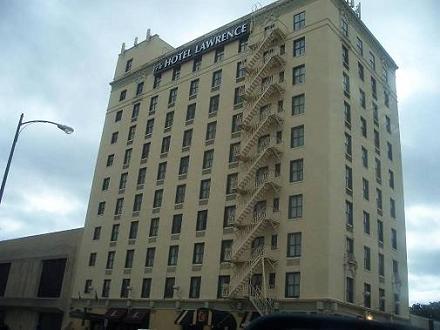The magnificent Georgian Revival landmark located at 1509 Pennsylvania Avenue in Fort Worth, Texas, was designed by the Fort Worth architectural firm of Sanguinet and Staats. Once the home of wealthy cattle barons, it is today a venue for weddings and other special events. Though last utilized as a residence decades ago, the mansion, according to some, is yet the abode of occupants of the spectral kind.
Originally constructed during 1903 and 1904 in the colonial style, this historic three-story mansion was built for newly-wed Electra (Waggoner) Wharton, the second oldest of five children and the only daughter of wealthy rancher and oilman William Thomas ("Tom") Waggoner and his wife Ella (Halsell) Waggoner, shortly after Electra's June 10, 1902, marriage to prominent Philadelphian Albert Buckman Wharton, whom she had met in 1901 while touring the Himalayas. Electra named the home "Thistle Hill."
Sources differ concerning construction costs (ranging from $38,000 to $46,000) of the 11,000-square-foot, eighteen-room home. The red brick exterior is bordered with cast stone trim, and white wooden stylistic elements trim and accentuate the roof and exterior walls. Semicircular bays flank the main wing of the mansion. Inside, the home features built-in closets throughout. Intricate elaborate interior woodwork is represented by an elegant oak grand double staircase and entry hall. Plaster stenciling and Tiffany Palladian windows are additional attractive interior design features. The mansion has five full bathrooms and eight fireplaces. Period furnishings are featured throughout the thoroughly restored edifice.
The Waggoner family amassed their immense wealth from ranching and oil. In 1853, a year after Tom Waggoner's birth in Hopkins County, Texas, his mother died and his father, Daniel, set out to become a successful cattleman, establishing ranch headquarters in Wise County. Tom followed in his father's footsteps and by 1869 was made a full partner in the ranching enterprise. By 1879, Tom was manager of the Waggoner Ranch's China Creek headquarters in northwestern Wichita County. He continued adding to his land holdings and in 1909, having repeatedly noticed traces of oil in failed attempts to provide fresh water for his herds through drilling, leased 250,000 acres to Texaco. Subsequent oil discoveries led, after 1911, to the founding of Waggoner Refinery and other business interests which increased Tom Waggoner's wealth such that he became one of the richest men in the American Southwest.
Electra Waggoner was born near Decatur, Wise County, Texas, on 6 January 1882 at the ranch home, known as "El Castile," of her grandfather Daniel Waggoner (passport records however give 15 January as her birthday). (It was in this residence years later that she and Albert Wharton were wed.) She attended Southwestern University and Ward-Belmont College in Nashville, Tennessee, from which she was graduated. Soon thereafter she made her world tour during which she met her future husband. She died in New York, New York, on 26 November 1925. Albert Wharton, son of Mahlon I. and Sarah (Buckman) Wharton, was born in Fallsington, Pennsylvania, on 18 September 1879. Following his marriage to Electra, he owned and managed Fort Worth Auto and Livery Stable, the first automobile dealership of Fort Worth, which dealt in Winston and Franklin cars. He died in Los Angeles, California, on 13 August 1963. The Whartons were parents of two sons, Tom W. and Albert B., Jr. (the latter known as "Buster").
Tom Waggoner divided his estate and partitioned his lands among his three surviving children, each receiving 90,000 acres of land and 10,000 head of cattle. In 1910, the Whartons sold Thistle Hill and moved to the W. T. Waggoner Ranch (Zacaweista) near Vernon in Wilbarger County. Cattleman and real estate tycoon Winfield Scott (1849-1911) spent $90,000 in the purchase of Thistle Hill. He and his wife, Elizabeth (Simmons) Winfield (1861-1938) then undertook extensive remodeling (said to have cost $100,000) which included the addition of impressive limestone Tuscan columns that replaced the original large columns and the second-floor wrap-around porch across the front. Original wooden decorative elements were replaced with wrought iron and the original green wood shingles of the gambrel roof were replaced with green tiles imported from Italy. Scott died, however, before the completion of the remodeling. Elizabeth and her nine-year-old son, Winfield, Jr., took up residence at Thistle Hill in 1911. Mrs. Scott lived in the home until her death in 1938. Besides expanding the gardens, she added a pergola and tea house to the grounds which are fenced with brick walls and ironwork. Also, remaining on the grounds is a beautiful carriage house.
Following the death of his mother, Winfield, Jr., sold the home in 1940 for a mere $17,500 to the Girl's Service League of Fort Worth, which used the mansion as a dormitory for underprivileged girls until 1968 when the league sold it. Their purchase, use, and minor, surface repairs to the home ultimately saved the mansion from the wrecking ball. The home, then called "The Scott" stood empty until 1975 when a committee called "Save-the-Scott" leased and then later purchased the home for preservation. The group's slow and methodical restoration of the home returned it to its 1912 condition. In 1977 Thistle Hill was designated a Recorded Texas Historic Landmark and it is listed on the National Register of Historic Places. In January of 2005, Historic Fort Worth, Inc. (a non-profit charitable organization dedicated to historical preservation) was gifted the property and today continues with preservation activities as well as tours and rentals of the historic venue for private and corporate events.
Reports of two apparitions began to be made during the period of early renovations during the 1970's. One of them is said to be that of a woman dressed in white who appears on the landing of the grand staircase. Also, seen was the figure of a man dressed in tennis clothes, and some sources say, sporting a handlebar moustache. During this same period of renovations, workers reported music emanating from the closed-off third storey ballroom. Footsteps and voices are reported to be quite common in the mansion. During one paranormal investigation by reporters and ghost hunters on a night in October of 1997, disembodied voices and footsteps were heard, and a ghost hunter awoke to discover a dark shapeless materialization hovering over her. This strange form then disappeared when she turned on her flashlight. An interesting incident occurred in the ballroom involving a rocking chair said to have been ninety-seven years old at the time of the event. The chair was removed from the ballroom and covered with plastic. The chair was later found back in the ballroom, sans plastic, even though no one claimed to have moved it.
An online story, by-lined "Bogienova," (posted 12 September 2007) reports a sighting by that author's friend who was a bridesmaid in a wedding being held at Thistle Hill. Having been sent back upstairs to retrieve the bride's veil which had been left in a bridal dressing room, the bridesmaid passed a lady (whom she took to be a character actor) dressed in clothing from a much earlier era exiting a parlor near the dressing room. However, no such persons, she was soon informed, were utilized for such appearances, particularly during weddings. Could this lady in "period clothing" have been a ghost? Might she have been the lady previously seen on the stairway? Who are the ha'nts of Thistle Hill?
(Photo credit: View of the Thistle Hill Mansion at Fort Worth, Texas, used by permission of Historic Fort Worth, Inc.)






